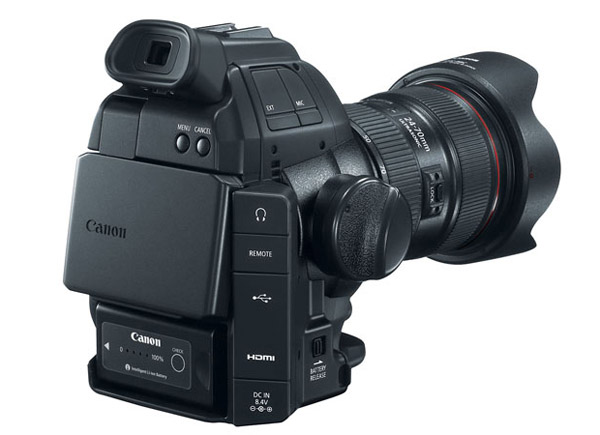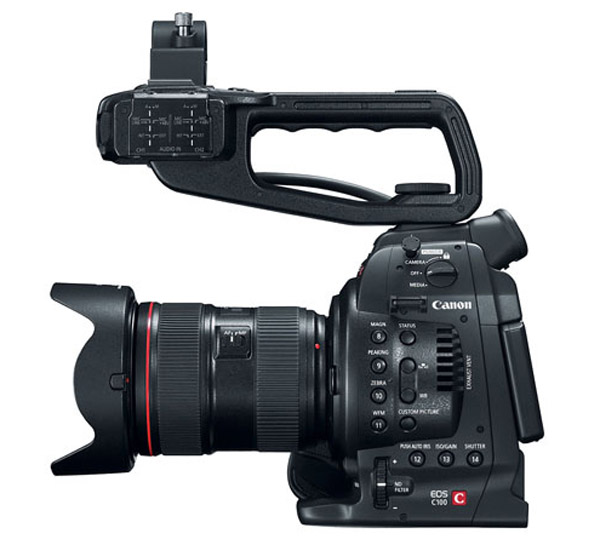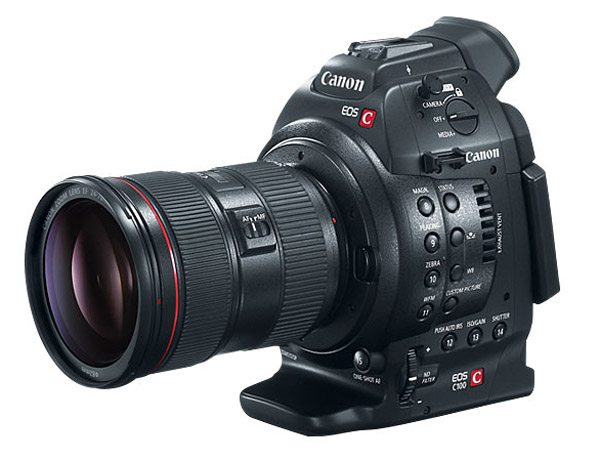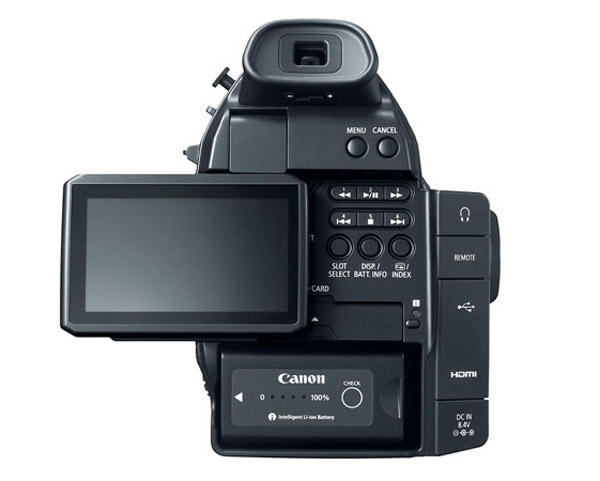By site editor Dan Chung:
Canon today launched their most affordable digital cinema camera to date in the shape of the C100. It is clearly the cheaper sibling of my favorite large sensor news and documentary camera the C300 – but with some features stripped away (although others are added). The C100 has the built-in ND filters and the great ergonomics of its sibling at a much lower cost. The detachable handgrip from the C300 is retained and means you can actually shoot the camera ‘naked’ without any sort of rig and still get some great results.
It also shares the same great Super35 CMOS sensor with excellent low light performance and great long life batteries. Also similar to the C300 is the built-in electronic viewfinder. The C100 like the C300 is also a true world camera with NTSC and PAL frame rates.
For many news and documentary shooters I can safely say this is the camera they have been waiting for.

So what’s different to the C300?
The C100 shoots to dual SD/SDHC or SDXC cards in full HD 1080P at 24Mbps AVCHD 4:2:0. This should be fine for many newspaper, web and budget TV shooters, but it is a less broadcast friendly codec than the C300’s 50Mb/s Mpeg2 4:2:2 MXF files. There is NO 50P or 60P framerate and it does not offer slow motion in its feature set.
Whilst it can also output uncompressed signals for external recording and monitoring via HDMI, the idea of adding an external recorder to gain higher quality also destroys many of the form factor advantages of C100 when it comes to run and gun work. For other kinds of work an external recorder may well offer a less expensive way to get C300-like image quality on a budget. The HDMI output also has an embedded time code which multi-cam operators may find useful.
The ND filters on the C100 are mechanical and not electronically controlled like the C300 – no great loss in my book.
Gamma settings on the C100 are also similar to the C300 – there is a C-log option for maximum gradability in post as well as more standard gammas. Interestingly, Canon also talk about the C100 having a Wide dynamic range gamma – something new that I have yet to find out about. Edit – This turns out to be a Rec gamma curve with some kind of knee that holds more highlight and shadow detail than a regular Canon Cine gamma.
In some ways it is better than the C300 for news work. It’s lighter, at approximately 85% of the weight; it has a 3.5 inch variable angle LCD on the body itself (not part of a jack pack like the C300); it has one-button-push auto exposure; and most importantly it has a one-shot autofocus system. The AF system is a bit of a mystery at the moment and it will be interesting to see just how fast and accurate it is – I can only assume it is similar to the one in the recently launched EOS M compact system camera. It’s great to see Canon listening to news and documentary shooters after initially offering only manual focus on cameras like the C300 and C500. Edit – There is now information that Canon will offer a future firmware upgrade to allow continuous AF with their latest STM type lenses.
Edit – Another great feature is a three second pre-record function which allows you to capture the moment just after it has passed. This feature is similar to that found on some ENG camera and as far as I know is a first on a Super35 sensor camcorder – I would find it very useful for some news assignments.
On the audio side, I for one am happy to see Canon do away with the C300’s combined monitor/audio jack pack in favour of a simpler audio add-on handle (included with the camera). However, the one main bugbear I had with the C300 remains, it seems, with the C100 – the audio pack’s connection to the main body is through a proprietary cable that is quite vulnerable to being knocked and damaged. The 3.5mm mic jack has also been carried over from the C300. Edit – The C100 also has a stereo mic built into the audio jackpack/handle. This will be a very welcome addition for many users who may just want to record ambient sound or a track for sync in multicamera applications. If it is anything like the mics in the XF105 and XF305 then they may actually be quite usable. Personally I would prefer to use this audio jackpack for run and gun shooting on the C300 as well, but when I asked Canon they told me it is not compatible.
The C100 also has a USB connection that the C300 doesn’t – hopefully this will allow for some level of camera control in a similar way to the Canon DSLR range. I will endeavour to find out if this is possible.
Another annoyance that has been carried over from the C300 and XF range of camcorders is the inability to record both PAL and NTSC framerates on the same card without reformatting – I wish Canon had fixed this.
With an estimated list price of $7999 US, and many dealers already offering pre-orders at discounted rates, it is pretty sure to sell well to the hordes of photojournalists, videojournalists and TV cameramen using Canon EF lenses who couldn’t or wouldn’t stretch to the C300.
The competition
The main competition to this camera is obviously Sony’s recent FS700 which offers similar AVCHD recording and ND filters in its body. The Sony also offers great high speed frame rates of up to 240fps in full HD – something the Canon just can’t do. Another plus with the Sony is XLR audio jacks built into the camera body itself – as opposed to on a jack pack. Sony are also dangling the carrot of a 4K upgrade to the FS700 at some point in the future.
The ergonomics of the Sony are not quite as straightforward as the Canon and most users will end up having to add some kind of rig for run and gun work. There is a similar rotating screen (albeit not as well positioned in my opinion) but no built-in electronic viewfinder. To use Canon EF lenses requires a third party adapter – the Metabones electronic adapter currently being the preferred choice, but adding cost.
Which camera you find more attractive will probably depend on how much you value slow motion shooting vs out-of-the-box functionality.
It is also worth remembering that the C300 has recently seen some discounted pricing and, in some countries, interest-free financing. If you want a true broadcast-ready camera then it is still a better option in my opinion. Sony’s F3 is also beginning to show up secondhand at attractive prices – it can be turned into a bigger ENG style camera quite easily by adding an EVF and shoulder mount, but to do so is not inexpensive.
The Canon C100 is expected to ship in November 2012. Canon today also confirmed production of the C500 4K cinema camera based on the C300 design, and also launched several new Cinema lenses – most interestingly the EF mount CN-E15.5-47mm T2.8 L S and CN-E30-105mm T2.8 L S lenses, and the same lenses in PL mount too.









